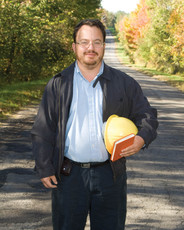Nov 25 2008
Comedians have made good use of "road kill" in their routines, but a Clarkson University professor began focusing attention on the problem after finding roads in Northern New York covered in green sheen from frogs who had been flattened by traffic.
 Tom Langen
Tom Langen
“I thought, wow, this happens and people never think much about it. It’s just an accepted part of the landscape,” said Tom Langen, associate professor of biology at Clarkson in Potsdam, N.Y. Langen, a California transplant, wanted to find out “whether this was a benign problem or if it was evidence of a larger environmental problem.”
He discovered that there was already a community of scientists and environmentalists looking at roads and their impacts on surrounding environments, including animal populations in a field of study called “road ecology.”
“In terms of a discipline, road ecology is still a pretty young field. It really only dates back to the early 1990s, when a few people started pointing out the deleterious effects of roads on the environment,” Langen says. There’s been a growing realization that many of the most complex environmental problems are located in the spaces where humans and the natural world intersect.
“We block roads out of our minds. We drive them all the time so we don’t even think about them,” Langen says. “However, if you were to look at a map you would notice roads are a dominant land use in America and all over the world. If you were to gather all the roads and right-of-ways in the continental U.S., it would cover the state of South Carolina.”
Four years ago, Langen and fellow researchers associated with Clarkson’s Center for the Environment and Paul Smith's College of the Adirondacks formed a multidisciplinary team to assess the long-term environmental consequences of current winter road maintenance practices on soils and lakes in the Adirondack Park, and to identify alternatives that were less environmentally harmful. The project was largely funded by the New York State Department of Transportation.
“The question we wanted to answer was how do we reduce some of the harmful effects of road deicing on the environment and still maintain safe winter travel?” recalls Langen. “Road salt (sodium chloride) is readily transported through soil and into water bodies. Although non-toxic in low concentrations, at high concentrations it stresses plants and animals, ultimately eliminating native salt-intolerant species and promoting the growth of salt tolerant ones, including exotic invasive species."
In the two lakes that were the primary focus of the study, Upper Cascade Lake and Lower Cascade Lake, the scientists found concentrations of chloride that were over 100 times higher than expected in typical Adirondack lakes. The high chloride concentration was linked to the heavy road salt and sand applications along Highway 73, a well-traveled road that runs through Lake Placid.
Langen and the research team recommended that certain salt-tolerant native plants be planted along the roads to restore vegetation and soil fertility, and that a target reduction of 15 percent less road salt use should prevent the water quality of the Cascade Lakes from further deteriorating. These recommendations are currently being implemented by the Department of Transportation.
Langen’s efforts at road ecology aren’t limited to upstate New York. He spent the last year in Central America, supported by funding from both the National Geographic Society and the Fulbright Fellowship Program, studying road ecology in Costa Rica.
“Costa Rica has one of the most extensive and best-managed systems of parks and protected areas in the world,” says Langen. “Many of Costa Rica’s parks, which serve as natural wildlife corridors, are bisected by major national highways. This disrupts connectivity by deterring migration or by causing excessive mortality due to road-kill.”
Langen not only studied animal migration patterns and identified hot spots of road mortality in Costa Rica, he also facilitated a number of workshops to help local transportation and park officials to understand road-related problems and find ways to mitigate them.